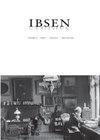The Struggle for Existence. Ibsen’s The Wild Duck (Vildanden, 1884)
IF 0.1
0 THEATER
引用次数: 1
Abstract
Moreover, the symbolism of the wild duck is clearly influenced by Darwin, either by Darwin’s reports in Variations of Animals and Plants under Domestication (1868) about how wild ducks degenerate in captivity (Bull 1932, 23–24; Downs 1950, 148–149; Zwart 2000, 94–95), or, more probably, by the chapter on domestication and variation in On the Origin of the Species (1859), which was translated into Danish in 1872 (Aarseth 1999, 127–128, 2005, 6; Rem 2014, 163). In the literature it is underscored that in this play Ibsen foregrounds domestication as degeneration, whereas Darwin’s main point is that it leads to variation in the species (Tjønneland 1998; Zwart 2000; Aarseth 2005; Shepherd-Barr 2015; Rem 2014). What I will argue is (1) that Ibsen, or the play as a whole, does not equate domestication with degeneration, (2) that the key to the play is the total constellation of animals and birds in the loft, not just the duck, and (3) that the loft is a scenic metaphor for the struggle for existence fought within and between the two families. In this way the image of the loft, an image in which the characters in the drama are reflected,为生存而奋斗。易卜生的《野鸭》(维尔丹登,1884年)
此外,野鸭的象征意义显然受到达尔文的影响,要么受到达尔文在《驯化下的动植物变异》(1868)中关于野鸭如何在圈养中退化的报告的影响(Bull 1932,23-24;Downs 1950,148-149;Zwart 2000,94-95),要么更可能受到《物种起源论》(1859)中关于驯化和变异的章节的影响,1872年被翻译成丹麦语(Aarseth 1999127-1282005,6;Rem 2014163)。文献中强调,在这出戏中,易卜生将驯化视为退化,而达尔文的主要观点是,它导致了物种的变异(Tjønneland 1998;Zwart 2000;Aarseth 2005;Shepherd Barr 2015;Rem 2014)。我要说的是:(1)易卜生,或者整个戏剧,并没有把驯化等同于退化;(2)戏剧的关键是阁楼里的动物和鸟类的整体,而不仅仅是鸭子;(3)阁楼是两个家庭内部和之间为生存而斗争的一个风景隐喻。以这种方式,阁楼的图像、反映戏剧中人物的图像,
本文章由计算机程序翻译,如有差异,请以英文原文为准。
求助全文
约1分钟内获得全文
求助全文

 求助内容:
求助内容: 应助结果提醒方式:
应助结果提醒方式:


